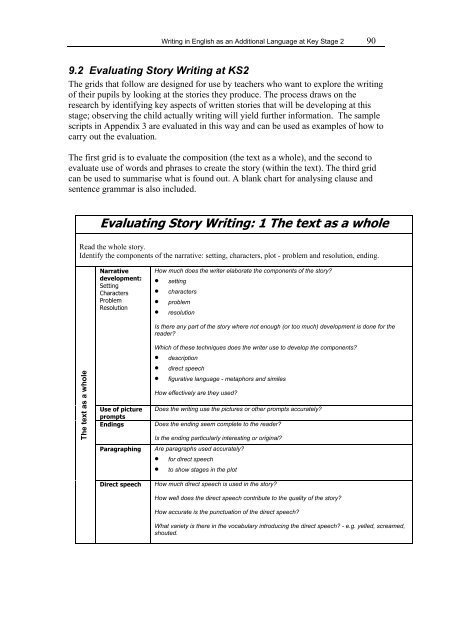Writing in English as an Additional Language at Key Stage 2
Writing in English as an Additional Language at Key Stage 2
Writing in English as an Additional Language at Key Stage 2
You also want an ePaper? Increase the reach of your titles
YUMPU automatically turns print PDFs into web optimized ePapers that Google loves.
<strong>Writ<strong>in</strong>g</strong> <strong>in</strong> <strong>English</strong> <strong>as</strong> <strong>an</strong> <strong>Additional</strong> L<strong>an</strong>guage <strong>at</strong> <strong>Key</strong> <strong>Stage</strong> 2 90<br />
9.2 Evalu<strong>at</strong><strong>in</strong>g Story <strong>Writ<strong>in</strong>g</strong> <strong>at</strong> KS2<br />
The grids th<strong>at</strong> follow are designed for use by teachers who w<strong>an</strong>t to explore the writ<strong>in</strong>g<br />
of their pupils by look<strong>in</strong>g <strong>at</strong> the stories they produce. The process draws on the<br />
research by identify<strong>in</strong>g key <strong>as</strong>pects of written stories th<strong>at</strong> will be develop<strong>in</strong>g <strong>at</strong> this<br />
stage; observ<strong>in</strong>g the child actually writ<strong>in</strong>g will yield further <strong>in</strong>form<strong>at</strong>ion. The sample<br />
scripts <strong>in</strong> Appendix 3 are evalu<strong>at</strong>ed <strong>in</strong> this way <strong>an</strong>d c<strong>an</strong> be used <strong>as</strong> examples of how to<br />
carry out the evalu<strong>at</strong>ion.<br />
The first grid is to evalu<strong>at</strong>e the composition (the text <strong>as</strong> a whole), <strong>an</strong>d the second to<br />
evalu<strong>at</strong>e use of words <strong>an</strong>d phr<strong>as</strong>es to cre<strong>at</strong>e the story (with<strong>in</strong> the text). The third grid<br />
c<strong>an</strong> be used to summarise wh<strong>at</strong> is found out. A bl<strong>an</strong>k chart for <strong>an</strong>alys<strong>in</strong>g clause <strong>an</strong>d<br />
sentence grammar is also <strong>in</strong>cluded.<br />
Evalu<strong>at</strong><strong>in</strong>g Story <strong>Writ<strong>in</strong>g</strong>: 1 The text <strong>as</strong> a whole<br />
Read the whole story.<br />
Identify the components of the narr<strong>at</strong>ive: sett<strong>in</strong>g, characters, plot - problem <strong>an</strong>d resolution, end<strong>in</strong>g.<br />
Narr<strong>at</strong>ive<br />
development:<br />
Sett<strong>in</strong>g<br />
Characters<br />
Problem<br />
Resolution<br />
How much does the writer elabor<strong>at</strong>e the components of the story?<br />
• sett<strong>in</strong>g<br />
• characters<br />
• problem<br />
• resolution<br />
The text <strong>as</strong> a whole<br />
Use of picture<br />
prompts<br />
End<strong>in</strong>gs<br />
Paragraph<strong>in</strong>g<br />
Direct speech<br />
Is there <strong>an</strong>y part of the story where not enough (or too much) development is done for the<br />
reader?<br />
Which of these techniques does the writer use to develop the components?<br />
• description<br />
• direct speech<br />
• figur<strong>at</strong>ive l<strong>an</strong>guage - metaphors <strong>an</strong>d similes<br />
How effectively are they used?<br />
Does the writ<strong>in</strong>g use the pictures or other prompts accur<strong>at</strong>ely?<br />
Does the end<strong>in</strong>g seem complete to the reader?<br />
Is the end<strong>in</strong>g particularly <strong>in</strong>terest<strong>in</strong>g or orig<strong>in</strong>al?<br />
Are paragraphs used accur<strong>at</strong>ely?<br />
• for direct speech<br />
• to show stages <strong>in</strong> the plot<br />
How much direct speech is used <strong>in</strong> the story?<br />
How well does the direct speech contribute to the quality of the story?<br />
How accur<strong>at</strong>e is the punctu<strong>at</strong>ion of the direct speech?<br />
Wh<strong>at</strong> variety is there <strong>in</strong> the vocabulary <strong>in</strong>troduc<strong>in</strong>g the direct speech? - e.g. yelled, screamed,<br />
shouted.

















